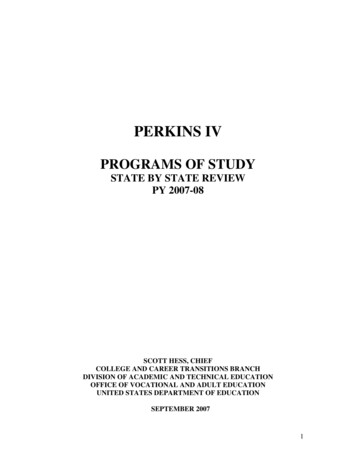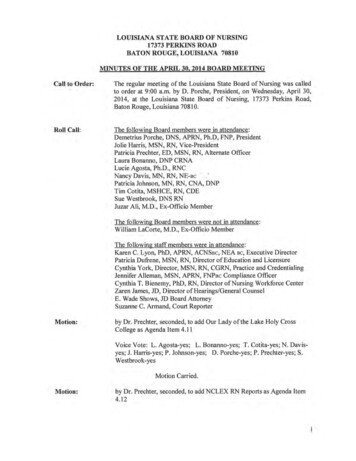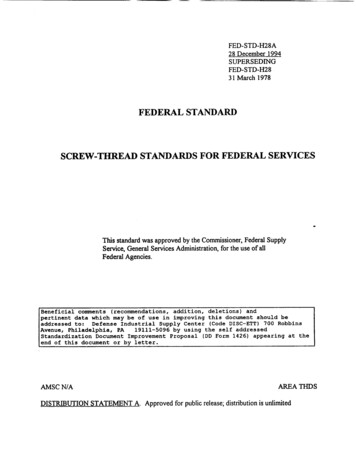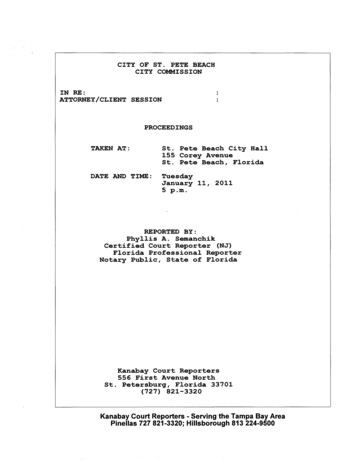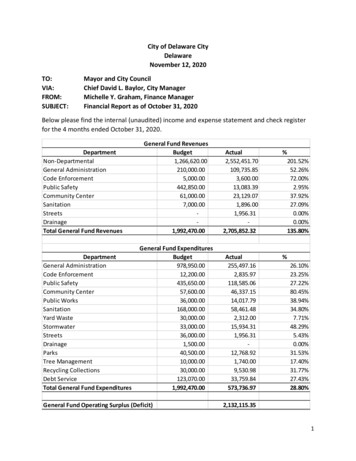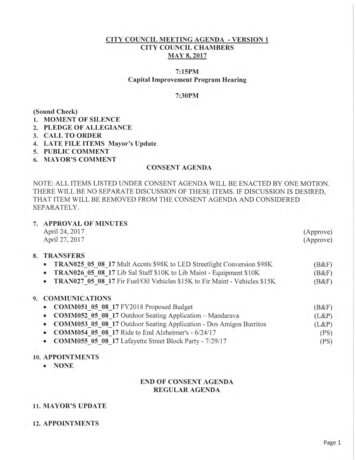
Transcription
FEDERAL PERKINS LOANA REFERENCE GUIDE OF YOUR RIGHTS, RESPONSIBILITIES AND OBLIGATIONS
City University of New YorkFederal Perkins Loan Reference GuideRevised, June 2009 by:Brenda Brown – York College, Claudius Christopher - Kingsborough Community College, Evelyne Jacques –Medgar Evers College, Daniel Padovano – Office of Treasury Management and Ellen Rondot – Queens CollegeEditing assistance by Tania Degen – Office of Treasury ManagementRevised, June 2003 by:Beverly Brown – York College, Jane Forman – The Graduate Center, Daniel Padovano – Office of TreasuryManagement and Ellen Rondot – Queens CollegeEditing assistance by Tania Degen – Office of Treasury Management and Martha Martin – Office of StudentFinancial AidJune 2000 version layout, design, text and editing by Eddie Kravitz – University Accounting Office.Editing assistance by Tania Degen – University Accounting Office and Martha Martin – Office of Student FinancialAid.Previous contributors include Steven Smith – The Graduate School and University Center, Geraldine Cicero – TheCollege of Staten Island, Janet Winter – John Jay College, Jane Tartaro – The Graduate Center and Beverly Brown –York CollegeSpecial thanks to The City University of New York, Council of Perkins Loan CoordinatorsThis information is deemed accurate as of June 2009Revised June 2009i
City University of New YorkFederal Perkins Loan Reference GuideThe student is the most important consumer of thishandbook. For the University to better meet yourneeds, we ask for your assistance. Help us to getyou the information that you need to make goodborrowing decisions.When you review thisthishandbook, if you think there is additionalinformation that should be included kindly advisethe Loan Coordinator at your campus so thatupdated versions of this handbook can reflect yourconcerns.On behalf of The City University of New York, thankyouyou and good luck with your educational pursuit.Revised June 2009ii
City University of New YorkFederal Perkins Loan Reference GuideThe Colleges of the City University of New YorkBaruch CollegeOne Bernard Baruch WayNew York, NY 10010Tel: (646) 312-1381www.baruch.cuny.eduJohn Jay College of Criminal Justice445 West. 59th Street, Room 1242New York, NY 10019Tel: (212) 237-8163www.jjay.cuny.eduBorough of Manhattan College199 Chambers Street, Room S320New York, NY 10007Tel: (212) 220-8063www.bmcc.cuny.eduKingsborough Community College2001 Oriental Boulevard, Room U201Brooklyn, NY 11235Tel: (718) 368-5983www.kbcc.cuny.eduBronx Community College2155 University Ave. Colston Hall Rm. 537Bronx, NY 10453Tel: (718) 289-5728www.bcc.cuny.eduLaGuardia Community College31-10 Thomson Avenue, Room C107Long Island City, NY 11101Tel: (718) 482-5191www.lagcc.cuny.eduBrooklyn College2900 Bedford Ave., Boylan Hall, Room 1147Brooklyn, NY 11210Tel: (718) 951-5000 Ext. 6297-6296www.brooklyn.cuny.eduCity College160 Convent Avenue, Admn Bldg, Rm.103New York, NY 10031Tel: (212) 650-8710www.ccny.cuny.eduCollege of Staten Island2800 Victory Blvd., Room 2A-102Staten Island, NY 10312Tel: (718)-982-2153www.csi.cuny.eduCUNY School of Law65-21 Main Street , Room 230JFlushing, NY 11367Tel: (718) 997-5111www.law.cuny.eduLehman College250 Bedford Park Blvd West,W. Shuster Hall, Room 034Bronx, NY 10468Tel: (718) 960-8414www.lehman.cuny.eduMedgar Evers College1637 Bedford Avenue, Room 110Brooklyn, NY 11225Tel: (718) 270-6132www.mec.cuny.eduNew York City College of Technology300 Jay Street, Room 1119Brooklyn, NY 11201Tel: (718) 473-8970www.citytech.cuny.eduQueens College65-30 Kissena Blvd., JH Room 202Flushing, NY 11367Tel: (718) 997-5111www.qc.eduGraduate Center365 Fifth Ave., Room 7201New York, NY 10016Tel: (212) 817-7460www.gc.cuny.eduQueensborough Community College225-05 56th Avenue, Library-Room 410Bayside, NY 11364Tel: (718) 281-5124www.qcc.cuny.eduHostos Community College500 Grand Concourse Savoy B-106Bronx, NY 10451Tel: (718) 518-4354www.hostos.cuny.eduSchool of Professional Studies101 West 31st Street Room 905New York, NY 10001(212)-652-2895www.sps.cuny.eduHunter College695 Park Ave., Room 1605 EastNew York, NY 10065Tel: (212) 772-4355www.hunter.cuny.eduYork College94-20 Guy R. Brewer Blvd., Room 1M08Jamaica, NY 11451Tel: (718) 262-2234www.york.cuny.eduRevised June 2009iiiGraduate School of Journalism365 Fifth Ave., Room 7201New York, NY 10016Tel: (212) 817-7460www.gc.cuny.eduThe City University of New YorkOffice of the University Controller230 West 41st Street 5th FlNew York, NY 10036(212)-397-5614www.cuny.eduFor access to the main web site andall colleges of The City University ofNew York:www.cuny.edu
City University of New YorkFederal Perkins Loan Reference GuideTable of ContentsYour Federal Perkins Loan .2Background Information about the Federal Perkins Loan program .2 Federal Perkins Loan Eligibility 2Student Financial Aid: A Loan Versus a Grant . 2Awarding the Loan 2Reduction of Your Federal Perkins Loan . . .2A New Academic Year and a New Loan .3Borrowing Limits . .3Interest Rate .3Grace Period . 3Grace Period and Military Service 4Before borrowing consider these facts 4 Minimum Monthly Payment . 4 How Much Can You Afford to Borrow .5 Budget Sheet . 6Your Lender 7Other Lenders .7NSLDS. . .7Federal Perkins Loan Billing Service . 8Pre-loan Counseling Session .8Exit Interview .9The Repayment Process . .9 Loan Prepayment .10 Multiple College Loans 10Cancellations . 10U.S. Army Loan Repayment Program 12Deferment . .12Forbearance 13Loan Consolidation .13Credit Bureau Reporting .14* Late Payments, Late Fees and Other Charges .14Loan Default .14 The Causes of Loan Default . . 14 Consequences of Loan Default .14Loan Rehabilitation .16Bankruptcy . 16Student Loan Ombudsman .16Glossary of Key Terms .17Useful Web Sites .20Revised June 20091
City University of New YorkFederal Perkins Loan Reference GuideYour Federal Perkins LoanThis handbook is provided to you as a reference guide about the Federal Perkins Loan program.In the following sections, you will find important information about your loan, including: Background information about the Federal Perkins Loan programFacts to consider before borrowingYour lender – The City University of New YorkPre-loan counseling and exit interviewThe Repayment processCancellationsDeferments, Forbearances and Loan ConsolidationsThe Consequences of Loan DefaultBackground Information about the Federal Perkins Loan programFederal Perkins Loan EligibilityIn general, to be qualified for a Federal Perkins Loan, a student must have sufficient financialneed, be matriculated with at least 28 earned credits, enrolled at least half-time (6 credits or 6equated credits) and meet all applicable academic standards. Freshmen and certificate programstudents are not eligible for the Federal Perkins Loan. Undergraduate students must maintain aminimum cumulative GPA of 2.0. If you are eligible for a loan the school you are attending willnotify you. However, you may also go to your Financial Aid Office and inquire about youreligibility. If you do not meet the criteria listed above, then you will not be eligible for theFederal Perkins Loan.Student Financial Aid: A Loan Versus a GrantLoans and grants are provided to you to assist in paying for your college education. The keydifference between receiving a loan and a grant is that a loan must be repaid and a grantdoes not. Only take out a loan if you need it. The decisions you make today on how tofinance your education will determine your future spending power. To learn more abouteducational financial assistance programs visit www.studentaid.ed.gov or your Financial AidOffice.Awarding the LoanYour Federal Perkins Loan is awarded to you based on an evaluation of your need for financialassistance. Guidelines for determining financial need are defined by the United StatesDepartment of Education. Although this Federal Perkins Loan is being offered to you, it is yourdecision to accept it. You may decline this loan and still remain eligible to receive a futureFederal Perkins Loan(s).Reduction of Your Federal Perkins LoanYou may request a reduction or cancellation of the amount that you are borrowing if you decidethat you do not need it. The college may reduce or eliminate the Federal Perkins Loan if you areover awarded because of other financial aid or scholarships, if during the school year you dropbelow half-time (6 credits or 6 equated credits), if you do not maintain a cumulative GPA of 2.0,or if you leave school. Remember, the less you borrow the less you have to repay.Revised June 20092
City University of New YorkFederal Perkins Loan Reference GuideA New Academic Year and a New LoanYou must apply each academic year to be considered for Federal Financial aid, which includesthe Federal Perkins Loan. We strongly encourage you to apply for a Personal IdentificationNumber (PIN) before beginning the FAFSA process. Your PIN is your permanent gateway tokeeping track of all your financial aid awards as well as access to NSLDS (see page 7). You mayapply for your PIN at: www.pin.ed.gov. As with any personal identifiable information, you mustguard your PIN as you would your social security number or bank account number. To apply forfinancial aid, you must file a FAFSA (Free Application For Federal Student Aid) which becomesavailable in January of each year. Your financial aid need is evaluated separately for each awardyear. Therefore, your eligibility and award amounts may differ from year to year.These are the Federal Borrowing Limits:GRADE LEVELANNUAL LOANLIMITAGGREGATE LOANLIMITONE & TWO 5,500.00 11,000.00THREE & ABOVE 5,500.00 27,500.00GRADUATE 8,000.00 60,000.00The amounts awarded within these Federal limits to CUNY student borrowers are determinedeach year by CUNY, depending on the availability of funds and the number of students applyingfor Federal Perkins Loans.Interest RateInterest, also called the finance charge, is the fee charged for the use of borrowed money. Theannual interest rate for all borrowers is 5%. As long as you are in school at least halftime, in yourgrace period, or deferment no interest accrues on your loan. Once you enter repayment, interestaccrues at the annual rate but is usually computed monthly and is calculated in terms of the totalamount of your outstanding principal balance.Grace PeriodThe initial grace period begins after you are no longer enrolled at an eligible status, meaningwhen you drop below half-time enrollment (6 credits or 6 equated credits), graduate, take a leaveof absence or withdraw from school. There is also a grace period after deferments.The initial grace period lasts nine (9) months; subsequent post-deferment grace periods are forsix (6) months.No interest accrues nor are payments due during a grace period. You have to begin repaying yourloan when your grace period ends.Revised June 20093
City University of New YorkFederal Perkins Loan Reference GuideGrace Period and Military ServiceYour nine month initial grace period excludes any period during which you are a member of areserve component of the Armed Forces named in section 101(d)(1) of Title 10, United StatesCode, and you are called or ordered to active duty for a period of more than 30 days.A borrower who is serving on active duty or performing qualifying National Guard duty inconnection with a war, military operation or national emergency does not need to pay principalor interest on Perkins, National Direct Student or National Defense Service Loans. Thedeferment period ends six months (180 days) after the borrower’s demobilization date for theeligible active duty or National Guard service.Members of the National Guard or the Armed Forces Reserve or retired members of the ArmedForces may be eligible for the Active Duty Military Deferment if they are enrolled in school, orwere within six (6) months of their initial grace period when called or ordered to active duty.This deferment allows for a new thirteen (13) month grace period upon completion of active dutyservice. If they re-enroll at school prior to the expiration of the thirteen (13) month cancellation,the deferment ends on the date of your re-enrollment (as you will again be in an enrolled status).Facts to Consider Before Borrowing:Minimum Monthly PaymentYour minimum monthly payment will be 40.00 as long as the amount you borrowed does notexceed 3,770.00. For loans greater than this amount, your monthly payments will be higher.Therefore the amount of your monthly repayment will depend on the total amount of FederalPerkins Loans borrowed. For an easy way to determine the approximate amount of yourmonthly payment use the following simple formula:Take the amount you owe and divide it by 1000. Multiply the number you get by 11.See the following examples:Total LoanAmount 4,000 5,000 15,000Revised June 2009Number ofPayments120120120ApproximateMonthlyPayments 42.43 53.93 159.104Total of InterestCharges 1,091.91 1,364.03 4,091.73Total Repaid 5,091.01 6,354.03 19,091.73
City University of New YorkFederal Perkins Loan Reference GuideBORROW RESPONSIBLYTHIS IS A LOAN AND MUST BE REPAIDDON’T GET IN OVER YOUR HEADHow Much Can You Afford To BorrowEvery borrower is different and the amount you can afford to repay in student loans depends onmany variables: Anticipated entry level salary for your professionTake home salary, i.e., what your net salary after taxes and deductions may beOther outstanding student loansCost of livingThe number of people you supportOther debts, i.e. auto loan or mortgageBefore you borrow take a few minutes to complete the budget sheet on the following page.Think about what you can really afford to borrow. You may find more information about entrylevel salaries by going to the Bureau of Labor Statistics homepage at www.bls.gov/oesEstimated Income and Expense SheetThis estimated income and expense worksheet is intended to help you develop an estimatedbudget to calculate and compare both your current and post-school income and expenses.Complete this sheet by filling in the appropriate dollar value next to each category that pertainsto you. You do not have to hand in this sheet. Keep this for your records and reference. Thisworksheet is a reference guide and should be updated as circumstances change.Please note that your GROSS wage is what you earn, however the amount you take home is theNET income, which is your GROSS wage less deductions for items which include but are notlimited to the following: taxes, Social Security, union dues, medical coverage. The NET wage iswhat you have available to spend. Remember to add up all of your income and expense items.Left over funds Net Income - ExpensesWhen you complete this worksheet think about what you can really afford to borrow fromthe Federal Perkins Loan program and what you may have to give up to pay the bill.Some useful financial management advisory web pages are:HESC: http://www.hesc.com/content.nsf/CA/2/Financial Literacy ProgramNew York City Office of Financial home.shtmlFEN (Financial Education Network) directory / referrals / general and shtmlRevised June 20095
City University of New YorkFederal Perkins Loan Reference GuidePERSONAL MONTHLY BUDGETPROJECTEDMONTHLYIncome 1Extra incomeTotal monthly incomeACTUALMONTHLYINCOMEIncome 1Extra incomeTotal monthly incomeEDUCATION:Tuition, Books andFees.HOUSINGCurrent ExpensesProjected ExpenseCURRENT BALANCE(Projected income minus expenses)PROJECTED BALANCE(Actual income minus expenses)DIFFERENCEDifferenceCurrent ExpensesProjected ExpensesDifferenceLOANSPersonalStudentCredit cardCredit cardCredit cardOtherSubtotalsCurrent ExpensesProjected ExpensesDifferenceTAXESFederal / FICAStateLocalOtherSubtotalsCurrent ExpensesProjected ExpensesDifferenceSAVINGS ORINVESTMENTSRetirementInvestmentSavings / OtherSubtotalsCurrent ExpensesProjected ExpensesDifferenceGIFTS ANDDONATIONSCharity 1Charity 2Current ExpensesProjected ExpensesDifferenceCurrent ExpensesProjected ExpensesDifferenceENTERTAINMENTMortgage or rentPhoneElectricityGasWater and sewerCableWaste porting eventsLive ORTATIONVehicle paymentBus/taxi sCurrent nt ExpensesFOODGroceriesDining outCurrent ExpensesProjected ExpensesProjected ExpensesProjected rent ExpensesPETSProjected s / GiftsSubtotalsLEGALAttorneyAlimonyLien or /nailsClothingDry cleaningHealth clubCurrent ExpensesRevised June 2009Projected ExpensesDifferenceTOTAL CURRENT COSTTOTAL PROJECTED COST6
City University of New YorkFederal Perkins Loan Reference GuideOrganization duesOtherSubtotalsYour Lender is The City University of New YorkYour lender is the CUNY college where you are enrolled and borrow your Federal Perkins Loan.The Federal Perkins Loan is part of Title IV Federal Student Aid programs that also include:FWS, Pell, SEOG, FFEL Stafford Loans and William D. Ford Federal Direct Student Loans. TheFederal Perkins Loan is a revolving loan, funded by the Federal Government and by repaymentsmade by prior borrowers. Their (and your) payments allow for newer borrowers (like you, now)taking this loan to pay for educational expenses. The CUNY college where you borrow islending you the money on behalf of the Federal government.The City University of New York consists of fourteen (14) senior colleges, six (6) communitycolleges, two (2) graduate schools and a law School. Schools are located throughout the fiveboroughs of New York City. Although all the colleges are part of the CUNY system, eachcollege is responsible for its own records, including your student loan records. Each schoolfrom which you borrowed a Federal Perkins Loan must be notified separately about anychanges in your address, telephone number, e-mail address, enrollment status or problemsyou may have with repaying the loan.Other LendersYou may have other lenders. They may include: The Department of Education for William D.Ford Federal Direct Loans, a major bank, alternative loan lenders, a student loan servicer oranother school’s Federal Perkins Loan. Each type of loan may have different provisions andmust be taken care of separately.Each of these loans is separate from each other, therefore everything you do for one loanyou MUST do for all: PaymentChange of Name, Address, Telephone number(s) and E-Mail addressChange of Social Security numberRequest for Defe
Baruch College One Bernard Baruch Way New York, NY 10010 Tel: (646) 312-1381 . Number (PIN) before beginning the FAFSA process. Your PIN is your permanent gateway to . Code, and you are called or



